#land of the najavo
Explore tagged Tumblr posts
Text
youtube
Peter Rowan Leads Phil Lesh & Friends into the Woods on “Clubhouse Sessions”
- Big band includes Stu Allen, John Molo, Barry Sless, Holly Bowling, Elliott Peck, Jason Crosby and Dan “Lebo” Lebowitz
Peter Rowan came to the Terrapin Clubhouse and took Phil Lesh & (a large group of) Friends into the country and bluegrass.
With the octogenarian - but not in the way - Rowan and Lesh at the helm, a stellar band of relative whippersnappers featuring guitarists Stu Allen, Dan “Lebo” Lebowitz and Barry Sless (pedal steel); singer Elliott Peck; drummer John Molo; fiddler Jason Crosby; and pianist Holly Bowling added respectful modernity to songs from Old & In the Way, Rowan and the Grateful Dead.
Though this was a one-off band for Episode 4 of Lesh’s “Clubhouse Sessions,” it couldn’t have been more tight but loose on “Dupree’s Diamond Blues,” which peaked as first Bowling, then Crosby and Sless transformed the studio into a dusty, Old West saloon. It’s a magical bit of musical inspiration made possible by players adept at picking their spots, Molo’s agile, light-touch drumming and a sonic approach that left room for Lesh’s bass to gurgle to the surface.
There’s not a wasted second in the 40-minute performance video, bookended as it is with a version of “Midnight Moonlight” that nods slyly to “Throwing Stones” and a “Dire Wolf” that finds Sless recalling Workingman’s Dead-era Jerry Garcia on the sit-down guitar.
Peck sings “Ripple” beautifully with Lesh taking over as the band crosses the bridge and Rowan reminds listeners he can still yodel on “Land of the Navajo.”
Beyond grateful for this magical offering.
Read Sound Bites’ coverage of the previous “Clubhouse Sessions” here.
6/21/24
#Youtube#clubhouse sessions#phil lesh & friends#phil lesh#grateful dead#peter rowan#old & in the way#elliott peck#midnight north#stu allen#dan lebo lebowitz#barry sless#moonalice#jason crosby#holly bowling#john molo#bruce hornsby and the range#midnight moonlight#dire wolf#land of the najavo#dupree’s diamond blues#ripple
6 notes
·
View notes
Text
Horse Issue, Land & Culture?
First off, I would like to begin this blog by saying that I am addressing the Navajo Nation Feral Horse issue with the understanding of the Navajo Culture being a Navajo woman born and raised on the Navajo Reservation all my life. Yet unique as I have acquired a degree in Animal Science therefore I have an understanding of the requirements for Equine health and resource needs as well as land stewardship.
The Navajo Nation is comprised of about 17 million acres which encompasses three states New Mexico, Utah and Arizona and on this large land mass there is what I consider a crisis of how to approach the feral horse population on the reservation. Based on the signed Treaty of 1868 which is the treaty between the Government and the Navajo Tribe that land allotted for the tribe in response to the release of the captive Navajos following the Long walk. This treaty allotted the land to the Navajo tribe and now known as the Navajo reservation. As the tribe lives on treaty land and are considered Sovereign Nation, we here on the Navajo Nation do not own the land therefore leasing or individual ownership of land is not allowed. Which in the case of land use is considered “open range” as long as the individual has a “Grazing Permit” which allows them the rights to graze the forage within specific location of the reservation, this has contributed to the issue of the feral horse problem as people do not properly manage both the land and livestock. Some of which own horses but allow them to roam the open range and have no use of the animals resulting in the feral population.
The open range, lack of horse management and cultural ties have made the addressing or identifying a solution to the feral horse problem very difficult. As of the last survey conducted by the Navajo Nation Game and Fish Department they have estimated 38, 223 horses were roaming across the Navajo Nation , this number was estimated almost three years ago meaning the number has increased. With these types of numbers on an already overgrazed landscaped that has also been plagued with 10 plus years of drought a solution is needed to reduce the herd numbers. Also when the United States outlawed the use of Horse Slaughter in 2007 the issue exacerbated, now those who wanted to sale horses they cannot afford to care for were not able to sell or only receive $10 per head, resulting in a number of horses being turned out on the reservation as abandoned.
Therefore when I make the statement of the “Navajo Nation Feral Horse issue hits home” this topic really does. Addressing the issue at hand for the Navajo/Native people becomes a double edged sword meaning that culturally the horse is a scared animal and we should not be slaughtering or mistreating them, yet the land “Dine’ Bikeyah”(Dine is the Navajo word for Navajo meaning “the people” and Bikeyah meaning “Our Land”) is also considered sacred. How do we address the every growing feral horse issue if we are tied culturally and restricted to solution ideas to address the increasing population?
Culturally the Navajos have always had a sacred belief of the horses, we have prayers, and songs that are specifically for the horses. They have always signified various things to the people including the seasonal rain that occurs, the Sacred Mountains, Sacred Stones and the way of life have been centered on horses. Yet the land has also a sacred merit as well to our people being through the creation stories and the deities that made us the land is to be cared for and considered valuable. In the mentioning of the cultural ties to the horse and to the land the management of both has not always been the best of practice either.
Again referring to the growing feral horse population as a “double edge sword” due to the cultural factor how can we address the problem? As due to the drought situation, overgrazing has occurred which is an indication of failed land stewardship and now these horses are also not in the best condition either some being plagued with sickness, inbreeding has occurred so genetically inferior and also suffering from malnutrition has resulted. In a news article there was 191 horses found dead in a watering hole because of lack of surface water these horses were unable to reach what water was available, got stuck in the mud and perished. The following link has the full story of the incident https://www.cbsnews.com/news/horses-found-dead-southwest-drought-arizona-najavo-nation/. My question as a Horse owner, Navajo Woman and a person in agriculture, is where do we draw the line between culture, and stewardship? Below is a photo of the horses that were found in Cameron AZ in the South western part of the Navajo Reservation. This does not mean that all horses on the Navajo reservation are mistreated, but the issue at hand is the free roaming feral horse population.
Some efforts included the proposed Horse Hunt that was put into play by the Navajo Nation Fish & Wild Life Department who was also responsible for the 2016 survey of horse population, the department had initiated a Horse Hunt Program. The Horse hunt program was announced and then within several days recalled as it sparked numerous concerns of humane, ethical and cultural reasoning, the hunt was then called off and made national news. The proposed horse hunt was a direct reaction to the horse population survey collected in 2016 and the hunt was announced May 2018 in efforts to reduce the population, a copy of the survey results can be found in the following link https://www.nndfw.org/ under “Report Survey of Free Roaming Horses pdf.” In the image provided is the official announcement of the Horse Hunt that caused a stir locally, state wide and nationally. Once the hunt was cancelled, the nation began to seek more options to control the horse population. Some suggestions included the use of Equine Birth Control injection called Porcine Zona Pellucida or “PZP” which is an injection for mares as an effective means of birth control. Although effective this method requires additional resources such as darts, darting guns, PZP injection, transportation that allows access to herds in some cases use of a helicopter. As you would imagine this is a costly method and requires multiple injections as well as close monitoring of the mares to ensure no breeding has occurred. This method has not been utilized on the Navajo Nation for population control, but has been successful in addressing Wild Horse Population on Bureau of Land Management BLM) and private land
Some other methods that have been the most popular was the horse round ups and selling to a broker into Mexico for processing. There have been effective reduction in numbers through this method but has also been a challenge as this requires man power, transportation, identifying a broker and of course although this is not a method of hunting or direct slaughter there are individuals who try to interfere with these round ups and have been reported to release the horses as well. Labor intensive, and costly but this has been helpful in reducing the numbers but has not made a significant dent in the overall population reduction.
The most recent efforts from the Navajo Nation Department of Agriculture has offered a Equine Reward Program which the department will pay $50 per head for any horse/mule/donkey that is unbranded. This has been held in various locations on the Navajo Nation and they have been able to put the gathering and round up on any person who wants to participate and bring horses to the location. The program as of June 2018 has reduced the herd size by 2, 034 feral horses per an interview with Roxie June, Navajo Nation Department of Agriculture in the Albuquerque Journal, more details in following link https://www.abqjournal.com/1207946/navajo-agency-rolls-out-feral-horse-program.html. Although this is a reward program and does not reduce the herd at an astounding number it is getting some removed from the reservation.
As an Agriculture Extension Agent I try and use my education as well as my cultural knowledge to educate and provide information to the community. I address the issue from a conservation, land steward stand point but also provide the cultural sensitivity as well. Although a double edged sword I do hope that through education and outreach we can continue to work on methods to address the Feral Horse issue on the Reservation. As there is no one fix all to the problem but will take several avenues to reduce and manage herd numbers but with special efforts to not disregard the cultural ties nor the humane and overall wellbeing of the horses as well as land. A continuous effort indeed.
1 note
·
View note
Note
Palestianians are angry because maybe their people are dying and they have nothing to go back at. No media coverage/support either of course. You have bad terrorist groups forming while others are in rubble. It's their land first. If natives came back into america and started taking your land you'd want to do something back won't you?
Like the Israelis, we do a hell of a lot to accommodate the native populations.
But unlike over there, the Najavo, Pima, Blackfoot, Cherokee and other tribes aren’t lobbing missiles and suicide bombers over the fence.
“This is our turf now. You may stay on it, but you have to play by our rules. And just to show no hard feelings, we’ll help you out if you need it too.” is the general (Not universal, I give you) sentiment in both cases.
And unlike the tribes here, the Israeli Jews have *nowhere* else to go. Furthermore, what do you think would happen to the Jewish cultural icons left behind if they decided to turn the Moon into New Israel and all left for it?
Nothing good, I promise you.
So it’s not exactly the same, across the board.
I hear you. I really do. But considering how big a dick Israel *could* wave, the fact that they *don’t* has to count for something.
1 note
·
View note
Photo

3/29/19
1:58pm
What is the craziest traveling adventure you have gone on?
Mine was this past Fall. In August, I took a flight to Denver, Colorado. After I landed, I got in a rental car and drove 8 1/2 hours W & SW to Oljato, Utah AKA Monument Valley, and stayed on the Najavo Reservation in a Hogan, a native American hut. I woke up the next day & walked outside, and monument valley was my front yard. I explored the desert that day and realized a lot.
0 notes
Video
#Repost @angryblackfemale @ig_repost_elf #repost_elf so we’re going to bypass #mcm and skip straight to #wcw b|c we’re totally crushing on #simonebiles who was the first gymnast in history to land a double somersault + twist dismount...this is #blackgirlmagic at its finest...i will say that i couldn’t help but stare at the american flag in the background esp after watching the #netflix #film “#basketball or nothing”...it follows the chinle high boys basketball team in their quest as the first all native team to win a state title...its shot in the heart of navajo nation and explores “rezball” [reservation basketball] and the “long walk to najavo” which was the forced deportation of natives to arizona + new mexico in 1864 which was the usa government’s attempt at ethnic cleansing...so imagine my surprise to see so many natives pledging allegiance to the flag as the national anthem played before each basketball game...native abfs please chime in b|c i’m really curious as ro why...anyways have a great week abfs [sidenote: while we’re on the topic of sports...can we discuss the ncaa aka “negroes can’t achieve anything” new requirements for sports agents...now you must have a college degree + pass a certification exam and background check...aka the “rich paul rule”...aka the we white privileged men w| ivy league educations and a good ole boys network can’t figure out how a black boy from ohio w| no formal education can land the greatest basketball player in the league [lebron james] after a chance meeting in an airport...so we’ll just create more systems of oppression b|c we can’t compete w| black excellence in a fair fashion...these white men are really shook...and prayers to serena williams for a speedy recovery] https://www.instagram.com/p/B1D9a1eH9vV/?igshid=1m54wpd99vpxz
0 notes
Photo

Saving Our National Monuments
Abbot Kinney Boulevard might be considered something of a ground zero for Venice gentrification, often showcasing a narrowing array of demographics. Yet that stopped nothing of the diverse group of concerned citizens -- young and old, bohemian and blue-collar -- that descended on the boulevard's G2 Gallery on Saturday, June 24th to help fundraise for our threatened National Monuments; specifically, for Southern California, the San Gabriel Mountains.
In 1906, Theodore Roosevelt created the Antiquities Act, which allows presidents to designate national monuments, and to criminalize any destruction or vandalism that occurs on such federal land. Imbedded in the act was a measure of territorial conservatism, to ensure little to no executive overreach. Yet President Obama, at least in the eyes of his ruthless successor, did in fact overreach in his late-hour designation of Utah's million-acre Bears Ears Monument, a stretch of land deemed sacred by the Najavo.
As a result, the current administration, as part of a toxic cosmos of regressive legislation, is revisiting the very existence of our national monuments going back to those created under Presidents Clinton and Bush. Should protections be stripped, these monuments would become vulnerable to privatization and exploitation. They include:
Grand Canyon -- Parashant, AZ
Grand Sequoia, CA
Canyons of the Ancients, CO
Hanford Reach, WA
Ironwood Forest, AZ
Vermilion Cliffs, AZ
Carrizo Plain, CA
Sonoran Desert, AZ
Upper Missouri River Breaks, MI
Papahanaumokuakea, HI
Pacific Remote Islands, HI
Rio Grande del Norte, NM
Organ Mountains-Desert Peaks, NM
San Gabriel Mountains, CA
Berryessa Snow Mountain, CA
Sand to Snow, CA
Basin and Range, NV
Mojave Trails, CA
Bears Ears, UT
Gold Butte, NV
The June 24th event of the Sierra Club Angeles Chapter included a wine and cheese table, a raffle off, and a heartening pile of letters to the administration petitioning to preserve the San Gabriel Mountains, all taking place under the watch of beautifully photographed, black-and-white African elephants, lions, zebras and mountain gorillas in the gallery's Susan McConnell exhibit. In the raffle, I myself was the fortunate recipient of a beautiful, Sierra Club-published book, Southern California Mountain Country: Places John Muir Walked and Places He Would Have Loved to Know. Browsing Muir's effusive writings on our natural spectacles, you wonder as to the stark contrast with personalities like Trump, who seem to regard the environment as some pesky afterthought that rudely invites itself to the table of other issues ... issues which, to be frank, are inescapably smaller by comparison. For the health and sanctity of our world contains all our affairs -- and all else.
Please take a minute to let Interior Secretary Ryan Zinke know how much you value national monuments. Click HERE for more information on how to submit comments, deadline is July 10th..
-- Mike Robinson Author / Editor www.mikerobinson-author.com (Official Site)
0 notes
Text

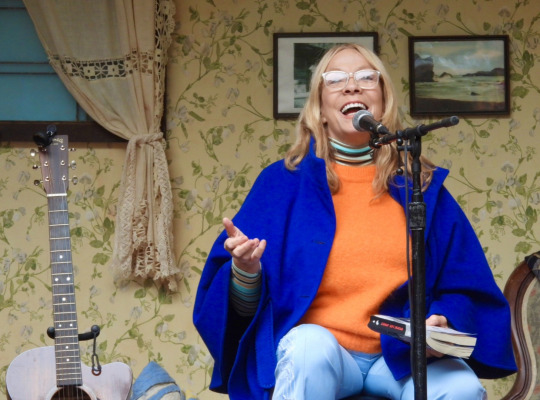

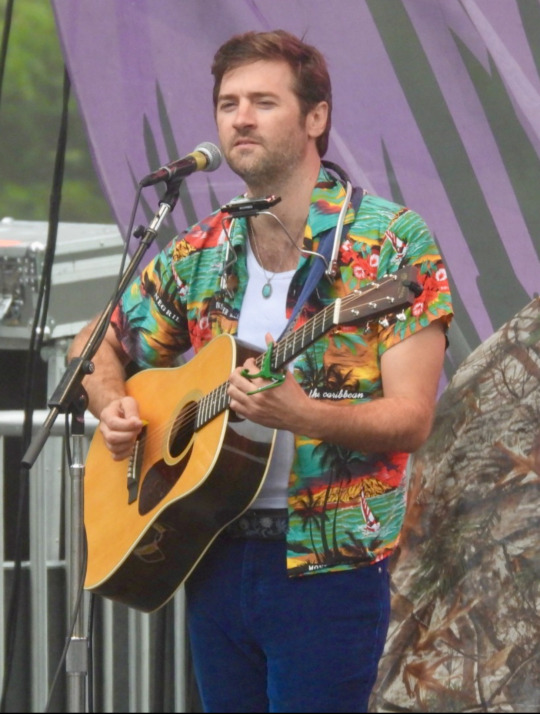

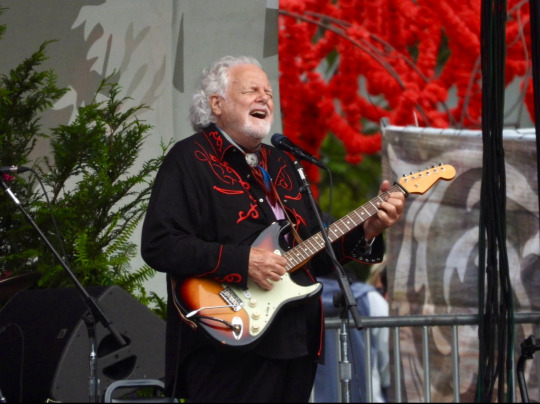
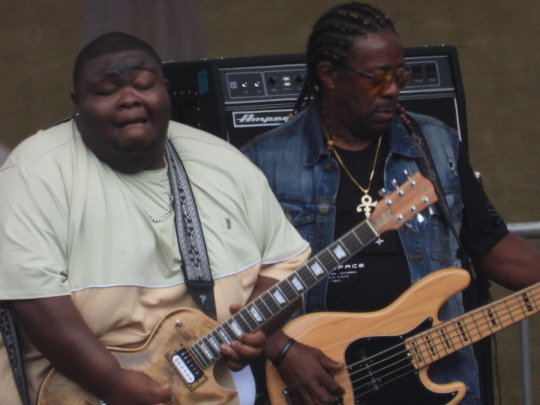
Hardly Strictly Bluegrass Day No. 1, Golden Gate Park, San Francisco, Sept. 29, 2023
- Rickie Lee Jones, Christone “Kingfish” Ingram, John Cragie, Peter Rowan and others highlight first day
Rickie Lee Jones opened the 2023 edition of Hardly Strictly Bluegrass - and christened the festival’s new, Horseshoe Hill stage - by reading from her 2021 memoir.
And Peter Rowan played country - not bluegrass - music during his late-afternoon set on the Banjo stage.
These were just two highlights from Day One at the long-running festival, which also included Christone “Kingfish” Ingram redefining the blues and John Craigie finding his quirky spot alongside Todd Snider in folk-Americana.
Seated on the small stage set up to resemble a living room and flanked with clothes drying on the line, an animated Jones embellished her reading from “Last Chance Texaco” with playful asides and wise cracks. She talked about how Laura Nyro made her feel connected and how Neil Young made her realize odd voices can be successful voices.
“I like it up here,” Jones said of being on stage. “I think artists sometime mistake the excitement for fear.”
Jones read about hitchhiking through California as a 14-year-old in 1969 as a foggy drizzle enveloped Golden Gate Park. She had soundchecked with a snippet of “The Horses,” but ended her well-received spoken-word gig by playing her father’s composition “The Moon is Made of Gold” solo and acoustic and earning a standing ovation from the small crowd seated in grass surrounded by tall trees.
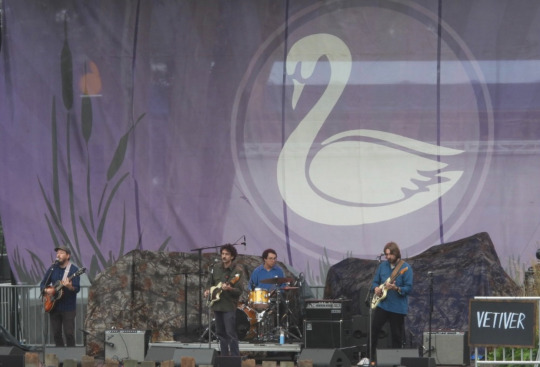
Afterward, Mr. and Mrs. Sound Bites took in a couple of numbers from Vetiver - think the Byrds with a slide guitarist - on the Swan stage as the blog couple headed for Ingram, who played before an audience of thousands on the Towers of Gold stage.
Borrowing Stevie Ray Vaughan’s tone and adding equal measures of funk and R&B, Ingram and his band were super-charged during 50 minutes of electrifying blues as they continually tore the music down before building it right back up. The guitarist sang of lost love on “Fresh Out;” walked off stage, but kept playing out of sight, to showcase his band on “Not Gonna Lie;” and engaged powerful call-and-response with his keyboardist during the set, which ended as Craigie took to the adjacent Swan stage.

Backed by electric bass and guitar and playing acoustic axe and harmonica, Craigie mixed humorous stage banter with tunes both playful (“I Wrote Mr. Tambourine Man”) and serious (“I am California”). Stage presence and song craft made fans of the Sound Biteses, who got their second dose of Craigie in as many days following the previous evening’s benefit for Camp Winnarainbow.

Bluegrass legend Rowan was the biggest surprise of the day, turning in a country and blues set that found him alternating between electric guitar and mandolin, supported by guitar, bass, drums and fiddle. This was exhilarating, though low volume at the Banjo stage lessened the impact of the instrumental guitar duel of “T Bone Shuffle” and made “Panama Red” -> “Freight Train” -> “Panama Red” sound like they were coming in on the winds from Ocean Beach.
Small price to pay for the opportunity to hear Rowan perform such warhorses as “Lonesome L.A. Cowboy,” “Land of the Najavo” and “Midnight Moonlight” in novel musical settings in the bucolic landscape of Golden Gate Park.
9/30/23
#hardly strictly bluegrass#2023 concerts#rickie lee jones#last chance texaco#john cragie#peter rowan#old & in the way#christone kingfish ingram#vetiver#laura nyro#neil young#stevie ray vaughan
7 notes
·
View notes
